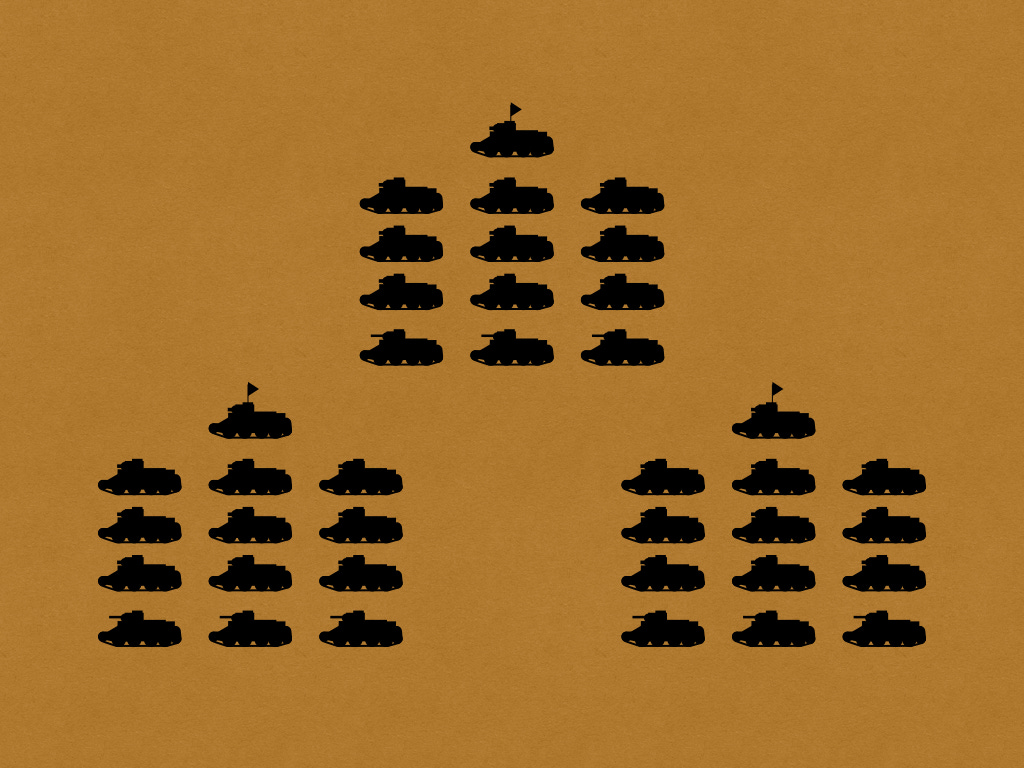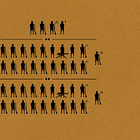Thanks to their organic field artillery battalions, the composite brigades that Major Patton imagined in the paper he wrote in 1932 possessed a great deal of tactical independence. Nonetheless, he imagined that, as a rule, they would normally operate as part of an infantry division. This larger formations would provide a variety of services, both logistical and informational, to its three brigades. It also possessed, in the form of a single tank battalion, a powerful means of reinforcing of pursuing a defeated enemy, conducting local counter-attacks, and completing the encirclement of an outflanked enemy.
Major Patton imagined the tank battalion of his division as a unit of three thirteen-tank companies, each with ten tanks “of the Vickers-Armstrong or modified Christie type” and three self-propelled “small cannon (about six-pounder) mounted on an identical chassis.” The mention of the six-pounder (57-mm) gun suggests that the other vehicles in the unit were armed with nothing more than machine guns. Similarly, while Vickers-Armstrong produced tanks in a variety of sizes, the US Army had recently taken delivery of Christie tanks that weighed in at a little more than eleven tons.
Each company was divided into three platoons, each of which consisted of three tanks and a single self-propelled gun. (The thirteenth tank in each company carried the captain who commanded the unit.) Major Patton called for the distribution of the self-propelled guns in this manner because he believed that the platoons would “operate on broad fronts and will often meet situations demanding IMMEDIATE [emphasis in the original] supporting fire.”
Like many cavalrymen of the 1930s, Major Patton imagined close cooperation between tanks and men on horseback. In particular, he foresaw situations in which horsemen would scout ahead of tanks, finding paths that allowed them to make good use of cover until the last possible moment. (“To use tanks for assault over open country,” Patton wrote, “is suicide.”)
Where the tank and infantry elements of his ideal infantry division were formed on a triangular framework, Major Patton believed that a cavalry unit of three company-sized units would be “too bulky to command.” Thus, the cavalry squadron he provided to his infantry division consisted of two troops of horsemen and a platoon of armored cars.
The departure from the general rule of the three-part division of the combatant battalions of his ideal division stemmed from Patton’s belief that a three-troop squadron would be “too bulky to command.”
The design of the horse cavalry troops made provision for two different modes of internal organization. The first option (depicted in the organigram) formed the troopers of each troop into three twenty-seven-man rifle platoons and a twenty-man machine gun platoon. (The latter wielded six of the same air-cooled tripod-mounted .30 caliber “light machine guns” that armed the machine gun squads of Major Patton’s infantry companies.)
The second option (depicted with silhouettes) assigned one of the three two-gun squads of the machine gun platoon to each of the rifle platoons of the troop. This turned the thirty-three-man reinforced rifle platoons that resulted into somewhat smaller versions of the forty-four-man rifle platoons of Major Patton’s proposal.
The eleven-man five-car armored car platoon of the cavalry squadron served several purposes. Primarily concerned with “bridging the gap between air reconnaissance and the relatively close work performed by the horseman,” it would “also be useful in covering night movements of tanks, in acting as a mobile reserve, and for general security.”
Believing that the value of an organic aviation element needed no explanation, Major Patton’s proposal provided little information about the squadron of seven observation aircraft that he provided for his infantry division.
Source: George S. Patton, Jr The Probable Characteristics of the Next War and the Organization, Tactics, and Equipment Necessary to Meet Them (Washington, DC: Army War College, 1932)
For Further Reading;












Fascinating ideas and an even more fascinating paper behind it. I am going to presume that the “trains battalion” in the organization chart would contain the medical and other sustainment units needed for the Infantry Division, as the discussion of the Cavalry Division does state that (the scan of the original paper is tough to read in spots and I could have missed it). Three other things stand out to me as a DAGB:
1. Patton either did not like, or completely forgot, about mortars as there are none of any flavor anywhere. The point made earlier by James Ackerman about von Schell and his dislike of mortars are valid here again. Patton must have agreed with him.
2. There is no provision for a communications unit of any kind that I can find. Any unit blessed with this amount of reconnaissance formations, ground and air, would want to know about enemy units, positions, dispositions and movements as rapidly as possible in order to see first and act first. Messengers alone would not sufficiently enable that in an already partly mechanized - motorized world.
3. The Artillery, both Field and Anti-aircraft, stops at the brigade or battalion level. There is no General Support Artillery battalion, no dedicated Anti-aircraft units and no Division Artillery HQ, unless it is contained in the Division HQ. This deprives the Division Commander the ability to protect his forces, immediately influence the close fight, coordinate with supporting artillery or to conduct any kind of a deep fight. You can’t always assume the Corps Artillery can support you.
Overall, this is a formation focused on mobility and the close fight at the expense of other issues. It would be at a severe disadvantage in open terrain (deserts, plains or steppes) or against a more motorized/mechanized opponent with more tanks, armored cars and artillery.
However, I can see how you could form an Operational Maneuver group for deep operations using the aviation unit, cavalry squadron, tank battalion and one the the brigade’s artillery battalions, but it would leave the rest of the division at a disadvantage unless it was really well dug in or in restricted terrain (I am assuming the engineer battalion could support the OMG’s mobility needs and the rest of the division’s counter mobility requirements).
That’s interesting!